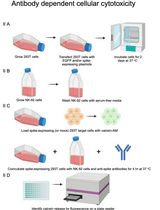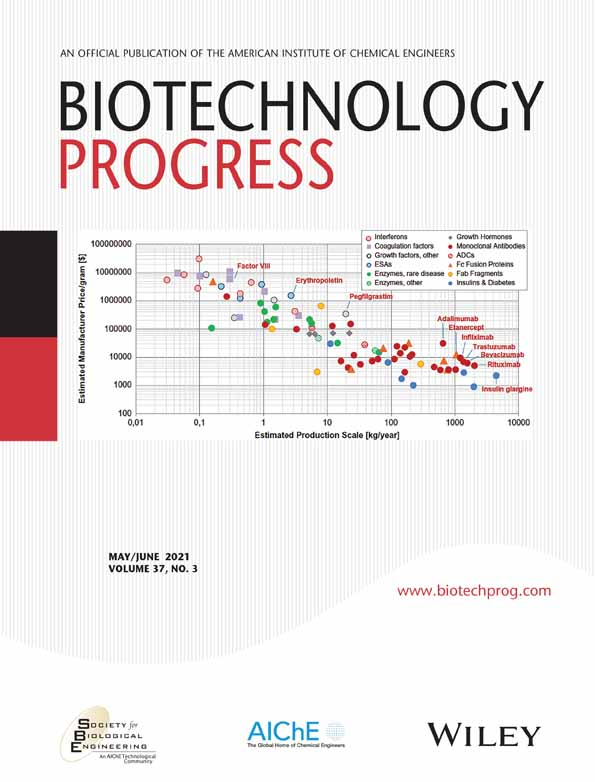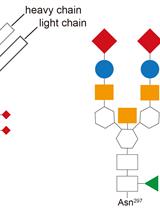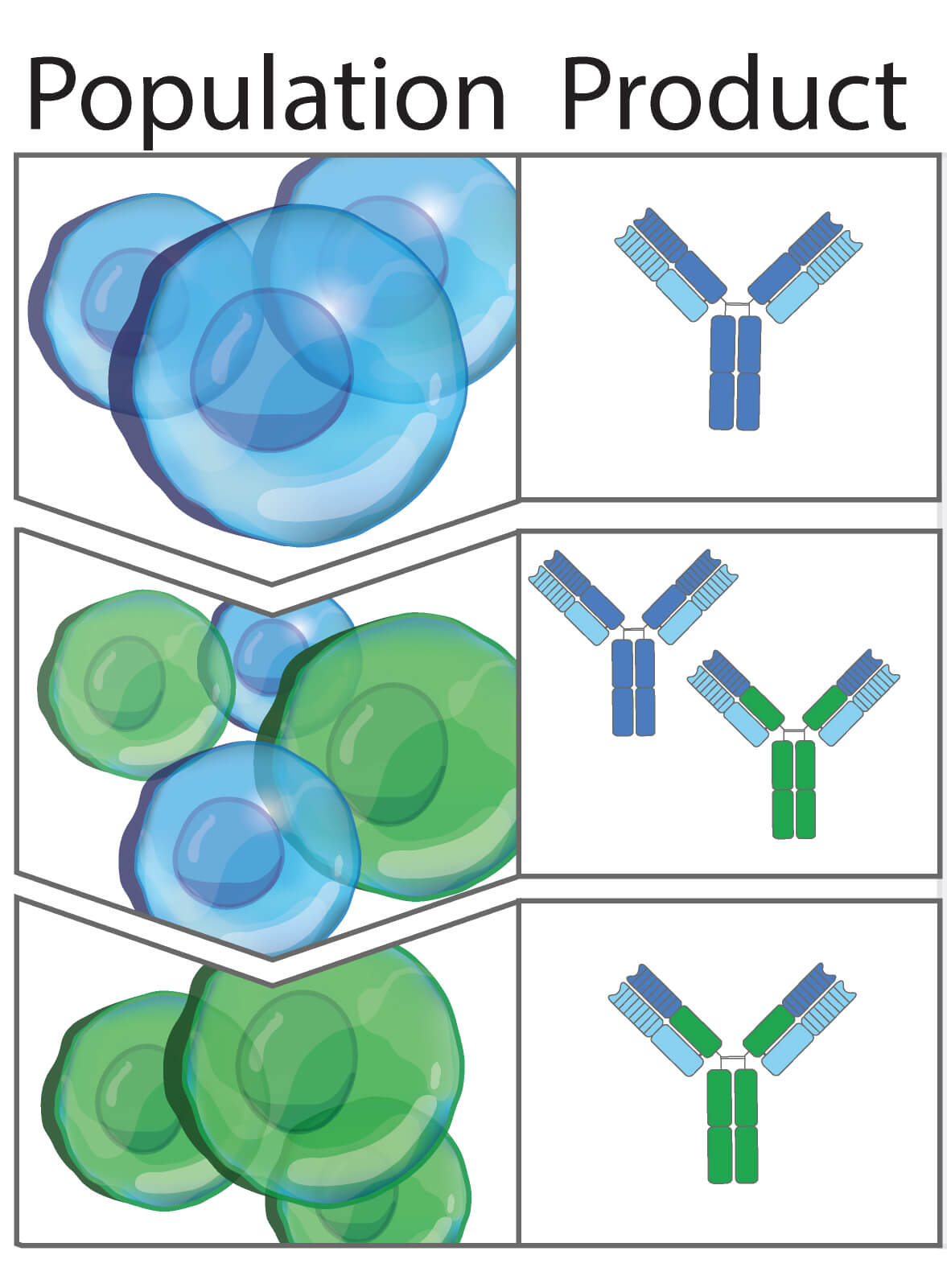- EN - English
- CN - 中文
Protocol for High Throughput Screening of Antibody Phage Libraries
抗体噬菌体文库的高通量筛选方案
发布: 2022年06月20日第12卷第12期 DOI: 10.21769/BioProtoc.4450 浏览次数: 5893
评审: Alba BlesaAnonymous reviewer(s)

相关实验方案

天然SARS-CoV-2刺突蛋白在哺乳动物细胞上的展示及其抗体亲和力和ADCC测定
Rebecca E. Wilen [...] Jennifer A. Maynard
2024年11月20日 2491 阅读
Abstract
Phage display is a proven and widely used technology for selecting specific antibodies against desired targets. However, an immense amount of effort is required to identify and screen the desired positive clones from large and diverse combinatorial libraries. On the other hand, the selection of positive binding clones from synthetic and semi-synthetic libraries has an inherent bias toward clones with randomly produced amber stop codons, making it more difficult to identify desirable binding antibodies. To overcome the screening of desired clones with amber codons, we present a step-by-step approach for effective phage library screening to isolate useful antibodies. The procedure calls for creating a simple new vector system for soluble production of phage ELISA positive binding clones with one or more amber stop codons in their single-chain antibody fragment (scFv) gene sequences, which is otherwise difficult in standard screening.
Graphical abstract:

Background
Biomolecules based on monoclonal antibodies are commonly utilized for disease detection and prevention (Borghardt et al., 2018; Parray et al., 2020; Kumaret al., 2022). The single-chain variable fragment (scFv) antibody is one of the most often exploited biomolecules because it is the smallest antibody unit and has low immunogenicity and low-cost production properties (Kumar et al., 2019b; Parray et al., 2020). The scFv is the most commonly employed combinatorial therapeutic entity, either alone or in combination with other medications (Frenzel et al., 2016; Kumar et al., 2019b). An antibody in the form of scFv has variable heavy (VH) and light-chain (VL) sections that are linked by an efficient linker that can be effectively produced in E. coli (Kumar et al., 2012; Kumaret al., 2019a). The phage display technique is the most popular and successful way of generating scFv antibody fragments among all in vitro display methods. The size and functional diversity of the library used for screening enhances the efficiency of isolating scFv molecules from phage display antibody libraries. The most common issue with the soluble expression of scFv clones from phage libraries is the higher frequency of amber codons within the scFv gene, resulting in the premature expression of scFv clones in non-suppressor E. coli strains. This is more common in the case of synthetic and semi-synthetic libraries because these libraries are constructed randomly at few residues—particularly at NNN, NNK, NWG, NWC, and NSG codons—which increase the biased inclusion of amber codons (Marcus et al., 2006). Due to the frequent presence of amber codons within antibody gene sequences, the isolation of functional soluble scFv molecules is the most prevalent problem encountered during the screening of synthetic and semi-synthetic libraries, resulting in premature expression of scFv clones in non-suppressor E. coli strains (Barderas et al., 2006; Perween et al., 2021a). However, the inclusion of an amber stop codon does not affect the display of scFvs on the phage surface in E. coli suppressor strains, but it reduces the overall yield in terms of the total number of functional soluble scFv protein-expressing clones.
Directing individual scFv genes to be resynthesized or using Kunkel mutagenesis are two popular ways to solve this problem. Both of these processes become expensive and time demanding, considering when the purpose is to screen a substantial proportion of clones, especially in viral targets where a large amount of screening is essential to generate a small number of neutralizing clones (Reader et al., 2019).
In this Bio-protocol, we describe a novel strategy for rapid screening of scFvs containing amber codons and turning them into usable soluble scFvs that can be applied to several phage antibody libraries. We discuss a fast and reliable screening strategy that can be used to screen a large number of phage antibody libraries with amber stop codons (TAG) in the encoding series.
Materials and Reagents
All chemicals are of Analytical Reagent Molecular Biology/Tissue culture grade.
| PRODUCT NAME | CATALOGUE NUMBER | COMPANY NAME |
|---|---|---|
| (3-(N-morpholino) propane sulphonic acid) MOPs | M1254 | Sigma-Aldrich |
| 2× YT media | G034-500G | Himedia |
| Absolute ethanol | 24102 | Sigma-Aldrich |
| Acetic acid | W200603-1KG-K | Sigma-Aldrich |
| Acrylamide | A8887-100G | Sigma-Aldrich |
| Agarose | MB080-100G | Himedia |
| Alkaline Phosphatase Blue Membrane substrate solution | AB0300 | Sigma-Aldrich |
| Ampicillin | SD002 | Himedia |
| Anti-rabbit HRP | Code: 111-035-144 | Jackson Immune Research |
| Beta-mercapto ethanol | 21985023 | ThermoFisher |
| Bis-Acrylamide | A2792-100ml | Sigma-Aldrich |
| Boric acid | MB007 | Himedia |
| Bovine Serum Albumin (BSA) | A3059-10G | Sigma-Aldrich |
| Bright-Glo Luciferase assay system | E2610 | Promega |
| Bromophenol Blue | B0126-25G | Sigma-Aldrich |
| Calcium chloride | GRM710 | Himedia |
| Cut smart buffer | B6004S | New England Biolabs |
| Cyclosporine | RM8155 | Himedia |
| DEAE-dextran | MB145 | Himedia |
| Diethanolamine | RM8218 | Himedia |
| Diethyl pyro carbonate (DEPC) | D43060 | RPI – Research Products International |
| Dimethyl sulphoxide (DMSO) | 673439 | Sigma-Aldrich |
| DpnI enzyme | R0176S | New England Biolabs |
| Dulbecco’s Modified Eagle Medium (DMEM) | 11965118 | GibcoTM |
| Ethylene diamine tetra acetic acid | GRM678 | Himedia |
| EXpi 293F cells | 100044202 | ThermoFisher |
| Ficoll | 26873-85-8 | Sigma-Aldrich |
| Gel extraction kit | 28706X4 | Qiagen |
| Gelatin | G2500 | Sigma-Aldrich |
| Glucose | MB037 | Himedia |
| Glycerol | MB060 | Himedia |
| Glycine | MB013 | Himedia |
| HisPurTM Ni-NTA Magnetic Beads | 88832 | Thermo ScientificTM |
| Histopaque | 10771 | Sigma-Aldrich |
| Hydrocortisone | RM556 | Himedia |
| Hydrogen chloride | 18-603-211 | ThermoFisher |
| Imidazole | MB019-100G | Himedia |
| Isopropyl β-D-thiogalactoside | RM2578 | Himedia |
| Kanamycin Sulphate | MB105 | Himedia |
| L-glutamine | 25030081 | GibcoTM |
| Ligase | 15224017 | InvitrogenTM |
| Ligase buffer | 46300018 | InvitrogenTM |
| LMB3 primer | Custom DNA oligos | Integrated DNA Technologies IDT |
| Luria Broth | M1245 | Himedia |
| Luria Broth Agar | M1151-500G | Himedia |
| Magnesium chloride | MB237 | Himedia |
| Magnesium sulphate | GRM1281 | Himedia |
| Methanol | 322415-250ml | Sigma-Aldrich |
| Mini prep kit | 27106X4 | Qiagen |
| Mono Sodium Phosphate | GRM3964 | Himedia |
| NcoI-HF® | R3193S | New England Biolabs |
| Ni NTA beads | 88221 | ThermoFisher |
| NotI-HF® | R3189S | New England Biolabs |
| Penicillin | SD028 | Himedia |
| PHEN primer | Custom DNA oligos | Integrated DNA Technologies IDT |
| Phosphate buffered saline | TS1101-20L | Himedia |
| Phytohemagglutinin (PHA) | 10576015 | GibcoTM |
| PierceTM Protein G Magnetic Beads | 88848 | Thermo ScientificTM |
| Polybrene (Hexadimethrine bromide) | H9268 | Sigma-Aldrich |
| Polyethylene glycol | MB149-500G | Himedia |
| Potassium Acetate | W292001 | Sigma-Aldrich |
| Potassium chloride | P3911-25G | Sigma-Aldrich |
| Potassium dihydrogen phosphate | PO662-25G | Sigma-Aldrich |
| RNase A | EN0531 | ThermoFisher |
| RPMI-1640 medium | 11875093 | GibcoTM |
| Skim milk | GRM1254 | Himedia |
| SnakeSkinTM Dialysis Tubing | 88244 | Thermo ScientificTM |
| Sodium Azide | GRM1038 | Himedia |
| Sodium bicarbonate | GRM849 | Himedia |
| Sodium carbonate | GRM851 | Himedia |
| Sodium chloride | MB023-1KG | Himedia |
| Sodium dodecyl-sulphate | 0227-10G | VWR Life science |
| Sodium hydroxide | 72064 | Sigma-Aldrich |
| Sodium phosphate dibasic Bio Reagent | NIST2186II | Sigma-Aldrich |
| Stop solution | N600 | Thermo Fisher Scientific |
| Streptomycin Sulphate | CMS220 | Himedia |
| Sucrose | MB025 | Himedia |
| TG1 Electrocompetent Cells | 23227 | Lucigen |
| TMB (Tetramethylbenzidine) Substrate solution | N301 | Thermo Fisher Scientific |
| Tris base | TC072 | Himedia |
| Tris Buffered Saline | R017R.0000 | ThermoFisher |
| Tris free base | MB029-500G | Himedia |
| Tris-HCl | MB030 | Himedia |
| Triton X100 | MB031 | Himedia |
| Trypan blue | T8154 | Sigma-Aldrich |
| Trypsin | TC598 | Himedia |
| Tween 20 | MB067 | Himedia |
Goat affinity purified Antibody to human IgG Fc, alkaline phosphatase conjugated goat affinity purified antibody to IgG Fc, and purified human IgG whole molecule were purchased from Cappel, MP Bio, USA.
A human mAb 1418 against parvovirus B19 was gifted by Dr. Zolla Pazner, NYU SoM, USA
Plasticware
All plasticware used is disposable (glassware is not used in this work).
| NAME | CATALOGUE NUMBER | COMPANY NAME |
|---|---|---|
| 96 well flat bottom Immunol plate for ELISA | CLS3370 | Corning |
| 96 well round bottom Immunol plate for ELISA | CLS3367 | Corning |
| 96 well tissue culture plate | CLS 3628 | Corning |
| Disposable pipettes of 5 mL, 10 mL and 20 mL | CLS4487 | Corning |
| Microfuge tubes 1.5 mL | CLS3620 | Corning |
| PCR tubes of 0.2 mL | PCR-02-A | Axygen |
| Petri dishes | 460062 | Tarson |
| Pipette tips 0.5–10 μL | AXYT300RS | Corning |
| Pipette tips 1–200 μL | CLS4860 | Corning |
| T-25 cm3 tissue culture flask | C6231 | Corning |
| T-75 cm3 tissue culture flask | C7231 | Corning |
BUFFERS
10× stock of gel loading dye (see Recipes)
2× Sample buffer (see Recipes)
Acrylamide:Bis (100 mL) (see Recipes)
Antibiotic concentration (see Recipes)
Buffer for Agarose Gel Electrophoresis (see Recipes)
Coating Buffer (see Recipes)
Composition of Reagents (see Recipes)
Counting of Expi293FTM Human Cells (see Recipes)
Destaining solution I (see Recipes)
Elution Buffer (1 L) (see Recipes)
Lower Gel Buffer [pH 8.8] 200 mL (see Recipes)
Lysis buffer (1 L) (see Recipes)
Phosphate buffered saline (see Recipes)
Purification of scFvs (see Recipes)
Tank Buffer 1× 2L (pH 8.3) (see Recipes)
Upper Gel Buffer [pH 6.8] 100 mL (see Recipes)
Wash Buffer (1 L) (see Recipes)
Wash Buffer (see Recipes)
Western Blotting solution (see Recipes)
Procedure
文章信息
版权信息
© 2022 The Authors; exclusive licensee Bio-protocol LLC.
如何引用
Singh, V., Garg, S., Raj, N., Lukose, A., Jamwal, D., Perween, R., Dhyani, S., Parray, H. A., Sharma, C. and Kumar, R. (2022). Protocol for High Throughput Screening of Antibody Phage Libraries. Bio-protocol 12(12): e4450. DOI: 10.21769/BioProtoc.4450.
分类
免疫学 > 抗体分析 > 抗体修饰
生物工程 > 生物医学工程
生物科学 > 生物技术
您对这篇实验方法有问题吗?
在此处发布您的问题,我们将邀请本文作者来回答。同时,我们会将您的问题发布到Bio-protocol Exchange,以便寻求社区成员的帮助。
Share
Bluesky
X
Copy link











